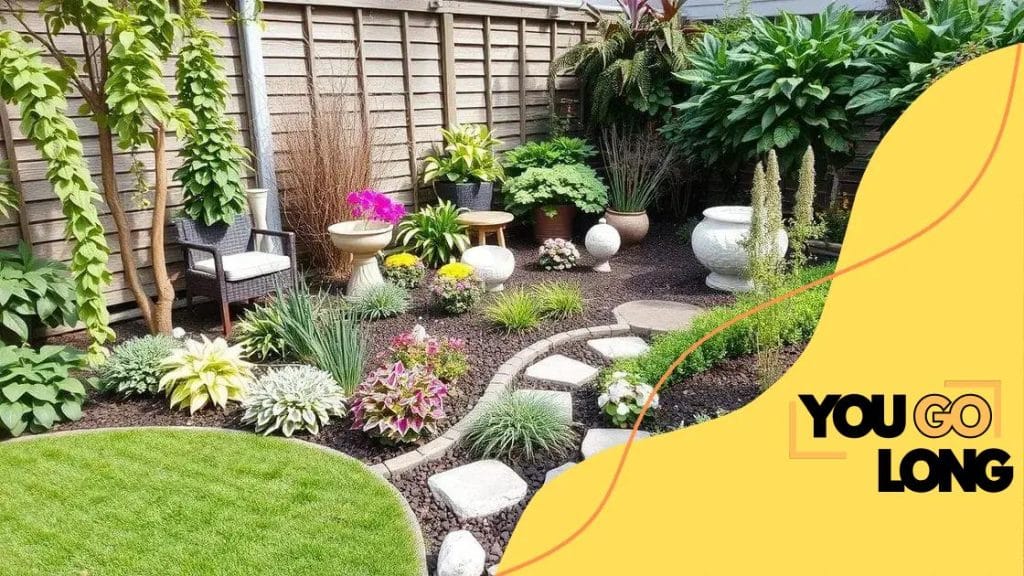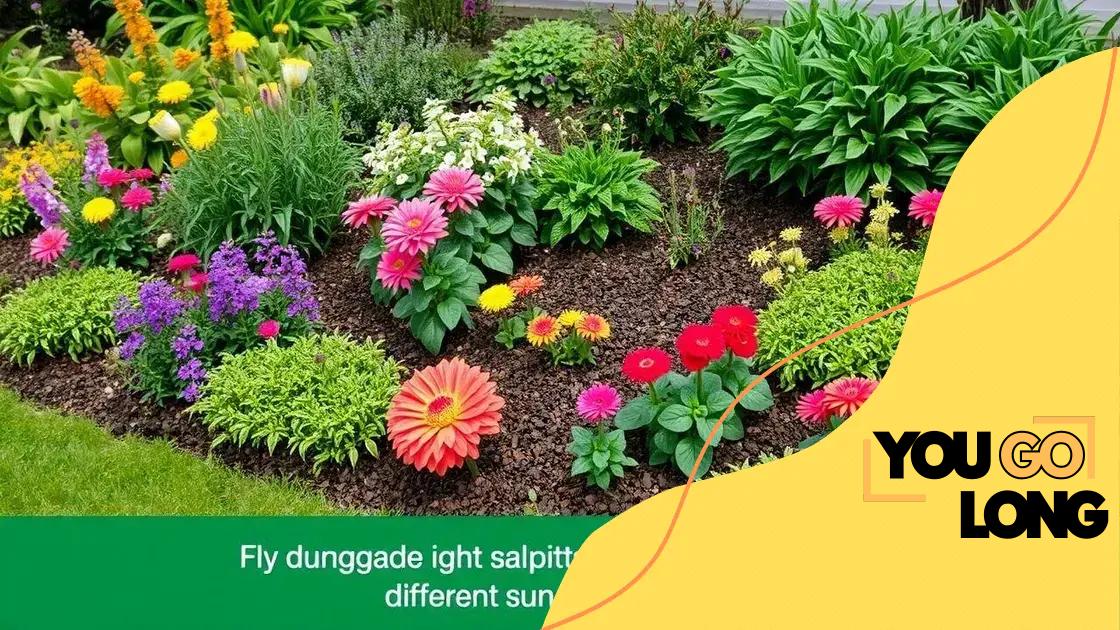Transforming your garden with creative landscaping ideas

Advertisement
Transforming your garden with creative landscaping ideas involves using native plants, decorative features, and sustainable practices to enhance beauty and functionality while supporting the local ecosystem.
Transforming your garden with creative landscaping ideas opens up a world of possibilities. Imagine stepping into an outdoor sanctuary that reflects your style and enhances your environment. Are you ready to rethink your garden space?
Understanding the importance of landscaping
Understanding the importance of landscaping can dramatically enhance the functionality and beauty of your outdoor space. A well-planned garden not only adds aesthetic value but also promotes environmental health and personal well-being.
When considering landscaping, remember that it is more than just planting flowers. It involves a harmonious design that incorporates nature into your living environment. Good landscaping can transform an ordinary yard into a peaceful retreat. Finding a balance between form and function is key to creating a space that meets your needs.
Advertisement
Benefits of Effective Landscaping
Effective landscaping offers several advantages. Here are some key benefits:
- Improves property value.
- Enhances outdoor experiences.
- Promotes biodiversity.
- Creates a tranquil environment.
Another important aspect to recognize is that landscaping can have a positive impact on the environment. For example, native plants require less water and maintenance. This not only conserves resources but also fosters local wildlife. Implementing sustainable practices such as rain gardens or xeriscaping can further enhance your garden’s ecological footprint.
Well-Designed Spaces
Creating well-designed spaces within your garden invites use and enjoyment. Consider zones for different activities, such as entertaining, relaxing, or gardening. These areas can be established with pathways, seating, and plant groupings that naturally draw the eye.
Advertisement
Furthermore, effective landscaping contributes to better mental health. Nature has a way of calming our minds and offering peace. Thus, incorporating green spaces within urban settings is crucial. Make sure to integrate seating options that allow for rest and reflection amidst your garden’s beauty.
In summary, understanding the importance of landscaping can lead to numerous benefits that enhance both your property and personal enjoyment. Invest time and effort into your outdoor spaces, and you will reap the rewards for years to come.
Creative ideas for garden layout
Creative ideas for garden layout can transform any outdoor space into a stunning oasis. By planning your garden carefully, you can create areas that are both beautiful and functional.
One popular approach is using raised beds. These structures not only add visual interest but also improve drainage and soil health. You can create various shapes, such as rectangles or circles, to define different areas within your garden.
Utilizing Vertical Space
Another innovative idea is to incorporate vertical gardening. This technique maximizes your space while adding depth and dimension. Consider using:
- Wall planters with cascading flowers.
- Trellises for climbing plants.
- Vertical gardens made from repurposed materials.
- Hanging baskets filled with colorful blooms.
These options allow you to enjoy diverse plant life without taking up much ground space. Additionally, they can create a more intimate and inviting atmosphere.
Creating Zones
When designing your garden, think about creating distinct zones for various activities. This could include a dining area with a table and chairs, a cozy spot with a bench surrounded by flowers, or a tranquil nook for relaxation. Think about how you want to use your garden.
Incorporating paths is vital for guiding visitors through these zones. You can use gravel, bricks, or stepping stones to connect different sections of your garden, encouraging exploration. During this process, be sure to consider how sunlight affects your plants, as some may need more or less light than others.
Choosing color schemes and themes is also an important part of garden layout. By selecting a cohesive color palette, you can create harmony throughout your space. Whether you prefer bright, bold colors or soothing pastels, be consistent in your choices to enhance visual appeal.
Thinking outside the box can lead to a garden that’s uniquely yours, full of personality and charm. Embrace your creativity, experiment with layout designs, and watch your garden flourish.
Choosing the right plants for your landscape

Choosing the right plants for your landscape is an essential part of creating a thriving garden. Selecting appropriate plants can enhance the beauty of your space while ensuring sustainability.
When you start this process, consider the climate of your area. Different plants have specific requirements for sun, shade, and moisture. Native plants are often the best choice because they are adapted to local conditions and support local wildlife.
Factors to Consider
As you plan your garden, keep in mind a few important factors:
- Sunlight: Determine how much sun your area receives daily.
- Soil Type: Test your soil to understand its composition.
- Watering Needs: Choose plants that match your watering preferences.
- Growth Size: Consider mature plant size to avoid overcrowding.
Another important consideration is the plant’s maintenance level. Some plants require more attention than others. If you lead a busy lifestyle, opt for low-maintenance varieties. This choice helps you enjoy your garden without the constant upkeep.
Creating Visual Interest
In addition to these practical factors, think about creating visual interest in your landscape. Mixing heights, colors, and textures can make your garden more appealing. For example, tall plants can serve as a backdrop, while low-growing flowers add vibrant color at the forefront.
Consider seasonal interest as well. Choosing plants that bloom at different times will keep your yard lively year-round. Incorporating evergreens can maintain color even in winter months. By planning a diverse planting scheme, you ensure there is always something to enjoy in your landscape.
Your local garden center can offer valuable advice and even display sample plants. Don’t hesitate to ask for recommendations based on your specific needs and preferences. By taking the time to choose the right plants, you will create a stunning landscape that brings joy and beauty to your outdoor space.
Enhancing your garden with decorative features
Enhancing your garden with decorative features can transform a simple outdoor space into a captivating retreat. These features add personality and charm, making your garden a reflection of your style.
One popular way to enhance your garden is by adding garden art. This can include sculptures, painted rocks, or unique planters. Art pieces can serve as focal points and spark conversation among visitors. Consider using art made from weather-resistant materials to ensure longevity.
Incorporating Water Features
Another exciting addition is a water feature. Water fountains or small ponds introduce soothing sounds and attract wildlife. Here are some options to think about:
- Birdbaths that invite birds to your garden.
- Small fountains that create relaxing sounds.
- Ponds that can host fish and aquatic plants.
- Waterfalls that add movement and drama.
These features not only enhance the aesthetic appeal but also create a tranquil ambiance.
Lighting for Ambiance
Lighting can also play a crucial role in enhancing your outdoor space. Soft lighting can make your garden inviting during the evening hours. Use path lights to illuminate walkways and highlight your plants. String lights can add charm to seating areas. Consider using solar lights that are energy-efficient and easy to install.
Furthermore, decorative trellises can define spaces while supporting climbing plants. This provides structure and can be an excellent backdrop for your garden art. Use materials such as wood or metal, and let your plants weave their way around them for a natural look.
Incorporating seating areas with cushions and throws makes your outdoor space even more inviting. Consider benches or hammocks under trees to create cozy spots for relaxation. A well-decorated garden reflects your creativity and becomes a place for you and your loved ones to unwind.
Sustainable landscaping practices to consider
Sustainable landscaping practices to consider are essential for creating beautiful, eco-friendly gardens. These practices help protect the environment while enhancing the beauty of your outdoor space.
One important aspect of sustainable landscaping is water conservation. You can achieve this by designing rain gardens that direct water runoff to plants that thrive in wet conditions. Additionally, using mulch around plants helps retain moisture in the soil. When selecting plants, opt for native species that are well-adapted to your climate, as they generally require less water and maintenance.
Soil Health
Maintaining healthy soil is crucial for a thriving landscape. Incorporate organic matter such as compost into your soil to improve its structure and fertility. Healthy soil supports plant growth and reduces the need for chemical fertilizers. Consider using cover crops in your garden beds. These plants prevent soil erosion and improve soil quality.
Choosing Eco-Friendly Materials
When creating pathways or outdoor structures, choose sustainable materials like reclaimed wood, natural stone, or permeable pavers. These materials reduce environmental impact and add character to your garden. It’s also important to minimize the use of chemical pesticides and fertilizers. Instead, explore natural alternatives like insect-repelling plants and organic treatments.
Another effective practice is to design your landscape for wildlife. Planting a variety of flowers, shrubs, and trees provides food and shelter for local birds, bees, and butterflies. This not only supports biodiversity but also helps pollinate your garden. Providing habitats for beneficial insects, like ladybugs and lacewings, can reduce pest populations naturally.
By incorporating these sustainable practices into your landscaping, you create an outdoor space that is not only beautiful but also contributes positively to the environment. Your garden can become a thriving ecosystem while promoting sustainability and conservation.
FAQ – Frequently Asked Questions about Creative Landscaping Ideas
What are some easy ways to start landscaping my garden?
Begin by planning your layout, choosing native plants, and implementing simple features like paths or decorative stones.
How can I conserve water in my garden?
Utilize rain gardens, choose drought-resistant plants, and apply mulch to retain soil moisture.
What decorative features can enhance my garden’s appearance?
Consider adding garden art, water features like fountains, and attractive lighting for ambiance.
Why is native planting important in landscaping?
Native plants are adapted to the local climate, require less maintenance, and support local wildlife.





